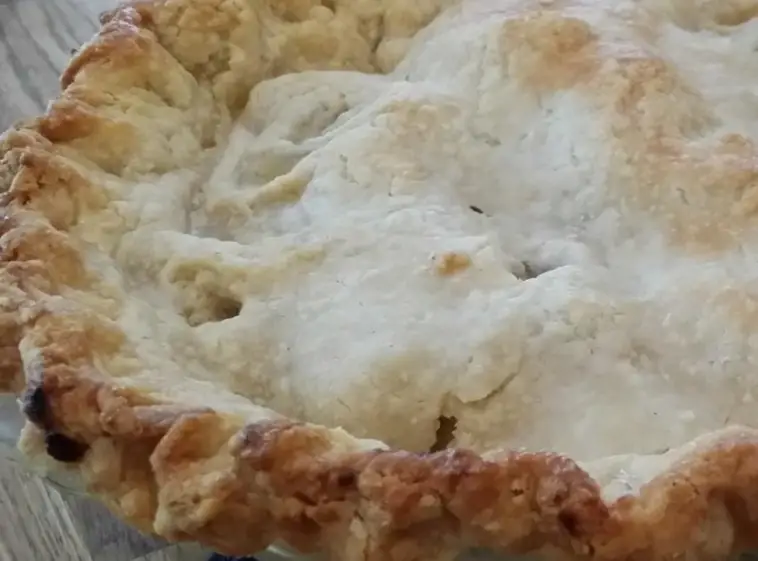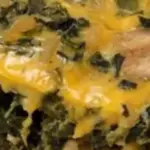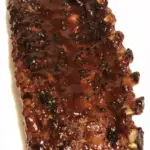A good pie starts with a great crust, and this Vinegar and Egg Crust is the perfect foundation for both sweet and savory pies. The addition of vinegar and egg creates a tender, flaky texture that is easy to work with and results in a beautifully baked crust. Here’s how you can make it.
Ingredients:
- 3 cups sifted all-purpose flour
- 1 ¼ cups shortening
- ½ teaspoon salt
- 1 egg
- 2 teaspoons distilled white vinegar
- 5 tablespoons ice water
Instructions:
- Prepare the Dry Ingredients:
- In a large mixing bowl, combine the sifted all-purpose flour and salt. Mix well to distribute the salt evenly throughout the flour.
- Cut in the Shortening:
- Add the shortening to the flour mixture. Using a pastry cutter or two knives, cut the shortening into the flour until the mixture resembles coarse crumbs. This can also be done using a food processor, pulsing the mixture until the desired texture is achieved.
- Add the Wet Ingredients:
- In a small bowl, beat the egg lightly. Add the vinegar and ice water, stirring to combine.
- Pour the egg mixture over the flour and shortening mixture. Use a fork to gently mix until the dough starts to come together. Be careful not to overmix; you want the dough to just come together without being too wet.
- Form the Dough:
- Gather the dough into a ball. Divide it into two equal portions. Flatten each portion into a disk. Wrap each disk in plastic wrap and refrigerate for at least 30 minutes. Chilling the dough makes it easier to roll out and helps to create a flakier crust.
- Roll Out the Dough:
- On a lightly floured surface, roll out one disk of dough to fit your pie dish. The dough should be about 1/8 inch thick. Gently transfer the rolled dough to the pie dish, pressing it into the bottom and up the sides.
- If making a double-crust pie, roll out the second disk of dough to the same thickness.
- Fill and Bake:
- Fill the pie with your desired filling. If using a double crust, place the second rolled-out dough over the filling. Trim and crimp the edges to seal. Cut a few slits in the top crust to allow steam to escape.
- Bake according to the specific pie recipe you are using.
- Blind Baking (if needed):
- For pies that require a pre-baked crust (like cream pies or certain fruit pies), preheat the oven to 375°F (190°C). Line the pie crust with parchment paper or aluminum foil and fill it with pie weights or dried beans. Bake for 15 minutes, then remove the weights and lining and bake for an additional 10 minutes, or until the crust is golden brown.
Cook’s Tips and Variations:
- Chilling is Key: Always chill your dough before rolling it out. This helps to relax the gluten and makes the dough easier to handle.
- Handle with Care: Be gentle when mixing and rolling out the dough to avoid overworking it, which can result in a tough crust.
- Butter Variation: Substitute half of the shortening with unsalted butter for a richer flavor.
- Flavor Twist: Add a teaspoon of sugar to the dough for sweet pies or a pinch of herbs like thyme or rosemary for savory pies.
FAQs (Frequently Asked Questions):
Q: Can I make the dough ahead of time? A: Yes, you can prepare the dough up to two days in advance. Keep it wrapped in plastic wrap in the refrigerator. You can also freeze the dough for up to three months. Thaw it in the refrigerator overnight before using.
Q: What can I use instead of shortening? A: You can use butter, lard, or a combination of butter and shortening. Butter will give a richer flavor, while shortening helps create a flakier texture.
Q: How do I prevent the crust from shrinking? A: To prevent shrinkage, make sure to chill the dough before rolling it out and again after placing it in the pie dish. Avoid stretching the dough when fitting it into the dish.
Q: Can I use this crust for savory pies? A: Absolutely! This versatile crust works well for both sweet and savory pies. For savory pies, you might want to omit the sugar and add a bit of seasoning to the dough.
Q: What if I don’t have a pastry cutter? A: If you don’t have a pastry cutter, you can use two knives to cut the shortening into the flour or use your hands. Work quickly to prevent the shortening from melting.
The Vinegar and Egg Crust is a classic recipe that ensures a tender, flaky, and delicious pastry every time. Its versatility makes it suitable for a variety of pies, whether sweet or savory. By following these simple steps and tips, you can create a perfect pie crust that will impress your family and friends. So roll up your sleeves, gather your ingredients, and get ready to bake the perfect pie!


